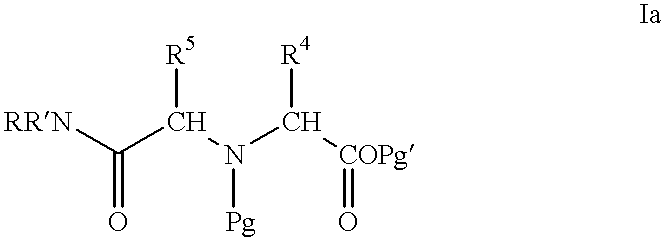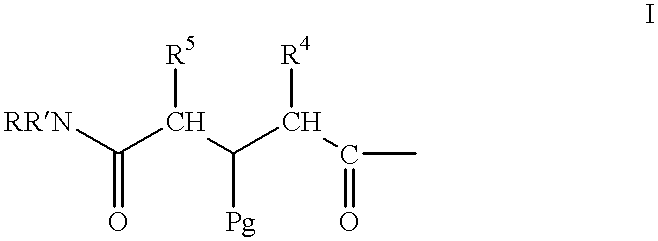Methods for hard-tagging an encoded synthetic library
a synthetic library and encoded technology, applied in the field of combinatorial synthesis synthesized synthetic chemical libraries, can solve the problems of cumbersome purification afterward, low quantity of material available for chemical analysis from complex libraries, and so little optical rotation that it is undetectable with present instruments
- Summary
- Abstract
- Description
- Claims
- Application Information
AI Technical Summary
Benefits of technology
Problems solved by technology
Method used
Image
Examples
example 1
This example exemplifies general methods for the synthesis of amine tags for use in this invention. The synthetic methods employed in this example are set forth below as well as in FIG. 1. ##STR7##
Reagents
Iminodiacetic acid (Aldrich), 5.0 g
Di-tert-butyl dicarbonate (Aldrich), 9.85 g
THF (Aldrich), 50 mL
Triethylamine (Aldrich), 2.43 g
Triphosgene (Aldrich), 0.84 g
Sodium bicarbonate, 12.6 g
To a solution of iminodiacetic acid 1 in 100 mL of THF and water (1:1) was slowly added sodium bicarbonate. After 10 minutes, di-tert-butyl dicarbonate was added. The solution was stirred for 2 days. After the THF was removed, the aqueous layer was extracted with ether twice, and acidified with 6N HCl (30 mL) to pH 1, extracted with ethyl acetate. The organic layers were washed with brine, dried over sodium sulfate and concentrated to give 8.1 g (92%) of Boc-diacid 2 which was recrystallized from hot ethyl acetate.
To a solution of 2.0 g of Boc-diacid 2 in 100 mL of ethyl acetate at 0.degr...
example 2
This example exemplifies formation of compound coupling sites and tag coupling sites on a solid support. The synthetic methods employed in this example are set forth below as well as in FIG. 1. ##STR8##
Reagents
TENTAGEL-130, a polystyrene-polyethyleneglycol graft copolymer with a diameter of 130 microns (0.3 mmol / g), (Rapp Polymere), 1.0 g
Fmoc-Gly (Advanced ChemTech), 200 mg
Boc-Gly (Aldrich), 13 mg
HOBT (Advanced ChemTech), 101 mg
DIC (Aldrich), 2 mL
Pyridine (Aldrich), 2 mL
Acetic Anhydride (Aldrich), 2 mL
DMF
DCM
HATU (Millipore)
DIEA (Aldrich)
TFA
TENTAGEL beads 5 in a solid phase reaction vessel (from ChemGlass, Inc., Vineland, N.J. 08360) were washed with DMF three times. To the beads was added a solution of Fmoc-Gly, Boc-Gly, HOBT and DIC in 3 mL of DMF. The beads were shaken for 3 hours and washed with DMF three times. Pyridine and acetic anhydride were added to cap the free amino groups. After 10 minutes, the beads were washed with DMF, methanol and DCM three times each and dri...
example 3
This example exemplifies the formation of a single encoded thiazolidinone compound on a solid support. This example demonstrates that encoded libraries of thiazolidinones can be straightforwardly prepared by incorporating resin splitting and pooling cycles at intermediate steps in the synthesis. The synthetic methods employed in this example are set forth below as well as in FIG. 5. ##STR9##
TENTAGEL beads 8a (0.2 g) prepared as above were washed with DMF three times. A solution of tags (La and 4b, 0.18 mmol total) prepared as in Example 1 above, HATU (68 mg) and DIEA (30 .mu.L) in DMF (0.2 mL) was prepared and mixed for 2 minutes before being added to the beads. The beads were shaken for 20 minutes and washed with DMF three times.
Piperidine in DMF (20%, 1 mL) was added to the beads. After 20 minutes, the beads were washed with DMF, methanol, and DMF again three times each. A solution of Fmoc-Gly (54 mg), HATU (68 mg) and DIEA (30 pL) in DMF (0.3 mL) was prepared and mixed for 2 minu...
PUM
| Property | Measurement | Unit |
|---|---|---|
| Structure | aaaaa | aaaaa |
| Fluorescence | aaaaa | aaaaa |
Abstract
Description
Claims
Application Information
 Login to View More
Login to View More - R&D
- Intellectual Property
- Life Sciences
- Materials
- Tech Scout
- Unparalleled Data Quality
- Higher Quality Content
- 60% Fewer Hallucinations
Browse by: Latest US Patents, China's latest patents, Technical Efficacy Thesaurus, Application Domain, Technology Topic, Popular Technical Reports.
© 2025 PatSnap. All rights reserved.Legal|Privacy policy|Modern Slavery Act Transparency Statement|Sitemap|About US| Contact US: help@patsnap.com



